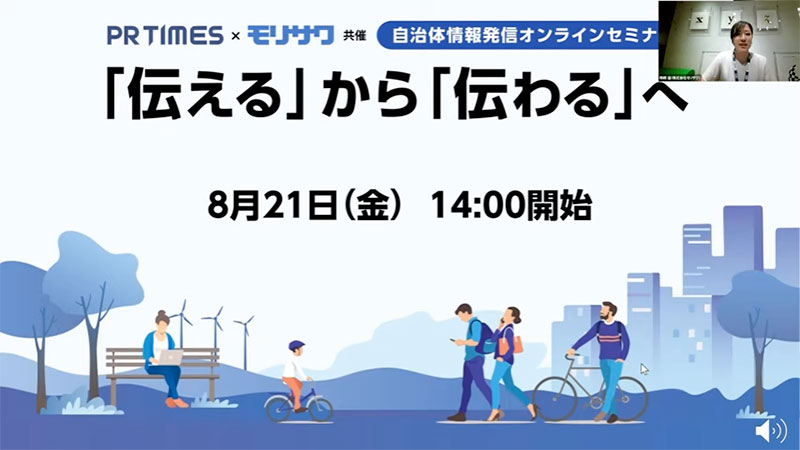
On August 21st, the PRTIMES x Morisawa Local Government Information Dissemination Seminar, "From 'Communicating' to 'Understanding'," was held online. We will report on the discussions that took place on the day.
Part 1: Universal design for information needed in the future and SDGs - Design examples for responding to the COVID-19 pandemic
Lecturer
Public Relations Advisor, Nakano Ward, Tokyo / Visiting Researcher, Waseda University Manifesto Research Institute
Tomoyuki Sakuma
Visibility over style
Sakuma, a former employee of Miyoshi Town, Saitama Prefecture, is a self-taught designer. His "Miyoshi Public Relations" magazine won the Prime Minister's Award at a public relations competition. He is currently active in a variety of fields, including as a public relations advisor for Nakano Ward.
The first thing Sakuma taught us was something called "nudge theory," a strategy that uses small triggers to change people's behavior. It seems like it could be widely applied by local governments, for example, to prevent tax delinquency by sending out envelopes in eye-catching red or yellow colors.
Next, Sakuma spoke in a gentle tone about the design mindset required of civil servants, saying, "Rather than being stylish, you should be conscious of readability." He says that when writing public relations materials, for example, he tries to use expressions that even a junior high school student can understand. He also says that it's important not to use too many colors. Even one color can become 100 colors if you change the intensity, so if you choose one base color and develop the colors around that, it creates a sense of unity and makes the material easier to read.
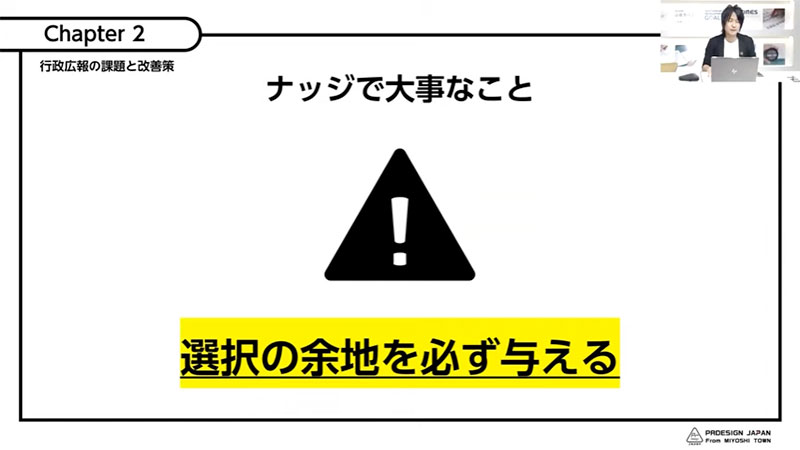
Digital technology should be utilized effectively in the future
Digital media is essential for disseminating information during the COVID-19 pandemic. Nakano Ward has placed QR codes on posters that lead to YouTube. They are using a cross-media approach of "images + videos" to communicate information to residents. For example, when reporting on a Coming of Age Ceremony, there is a limit to the number of images that can be published in a magazine, but by using digital media, it is possible to share every detail.
Of course, there are people who are not familiar with digital technology, so it is essential to continue to make announcements through flyers and, in the event of a disaster, to make announcements through the disaster prevention radio. What is important is to take into consideration "universal design (UD) of information" by making full use of various media so as not to create information-poor people.
Finally, Sakuma explained that it is not important to "communicate" but to "be understood." Creating something that cannot be communicated increases the number of people answering the phone and at the counter, placing an unnecessary burden on both citizens and those in charge. Last year, when Sakuma was still employed at Miyoshi Town, he worked overtime for a whopping 100,000 hours.zero"He concluded with a smile, "If you pay attention to what you want to communicate, you can make your work more efficient!"
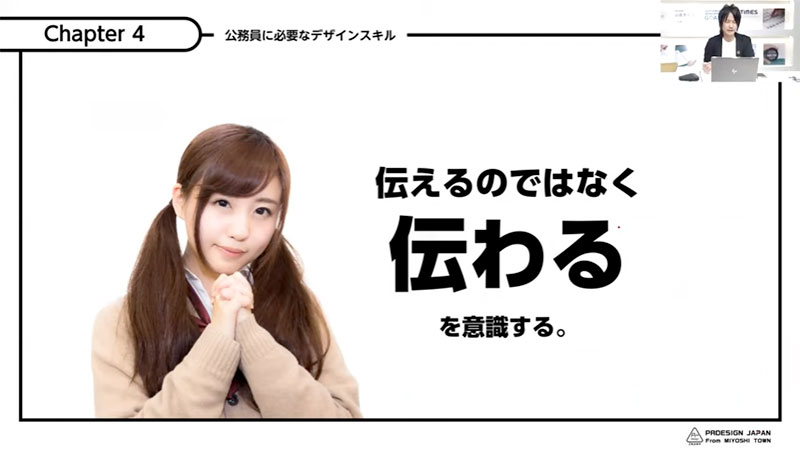
Part 2: Panel discussion: Practices and challenges of disseminating information from local governments that is easy to understand
Keisuke Saito, City Promotion Section, Public Relations and Hearings Division, General Policy Department, Matsudo City
Junichiro Seto, Brand and Communication Strategy Team, General Affairs Bureau, Hiroshima Prefecture
Moderator: Tomoyuki Sakuma
Matsudo City and Hiroshima Prefecture's Universal Design and SDGs Initiatives
The second part of the event was a panel discussion, moderated by Mr. Sakuma. In response to Mr. Sakuma's question, "Please tell us about your efforts to promote universal design of information and the SDGs," Mr. Saito of Matsudo City replied, "We have completed the Japanese voice readout and support for six other languages on our website, and we are currently working to make it compatible with universal design."
Meanwhile, Seto from Hiroshima Prefecture said, "We are mindful of SDG 11: Creating sustainable cities and towns, and are using Morisawa's app, Catalog Pocket, which has text-to-speech and multilingual functions, to disseminate information in multiple languages." Hiroshima Prefecture also launched TikTok this year to target younger generations who don't watch TV or read newspapers. When the Peace Memorial Ceremony was livestreamed, approximately 46,000 people watched. He said that 90% of those viewers were under the age of 24, and smiled, "I'm glad I did it."
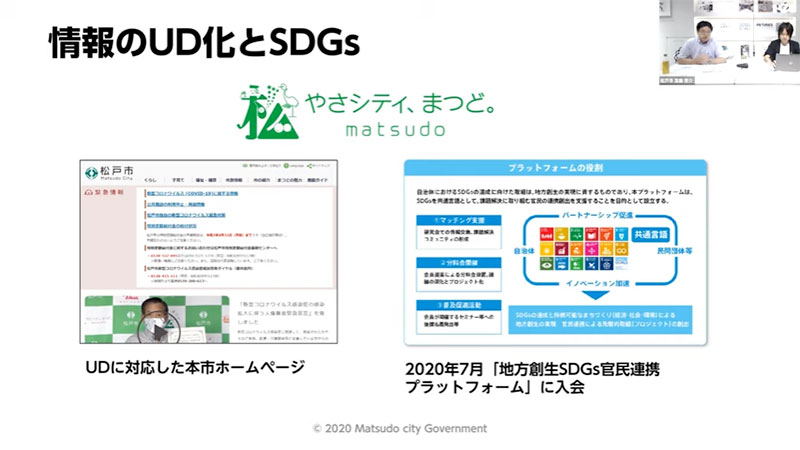
The usefulness of TikTok becomes clear
The conversation then turned to free social media, with Matsudo City using Twitter, Facebook, and Instagram. Sakuma immediately asked, "Do you need to pay internally?" and "Do you have your own smartphone?" Saito replied that they do need to pay internally, and that the city provides them with tablets, not smartphones.
As mentioned earlier, Hiroshima Prefecture has launched TikTok, and also utilizes Twitter, Facebook, and LINE. During the heavy rains of July 2018, they apparently posted 20 to 30 tweets per day. "We made an effort to distribute important information in a timely manner while devising the approval procedures," recalled Seto.
Concerns about information leaks regarding TikTok are spreading worldwide, but Seto says, "As the number of reports about TikTok has increased, the number of inquiries has also increased, but the number is not that high. When we inquired with ByteDance, the Japanese subsidiary, they told us that there are no issues with information leaks. Our prefecture is also working to avoid risks, such as providing smartphones specifically for TikTok."
Hiroshima Prefecture has high hopes for TikTok as a means of communicating information to young people, and while it would like to continue using the app, it will abide by the government's policy. In response to Sakuma's question, "Can local governments that are unsure how to use TikTok come to you for advice (laughs)?", Seto responded with a strong "We're waiting (laughs)!"
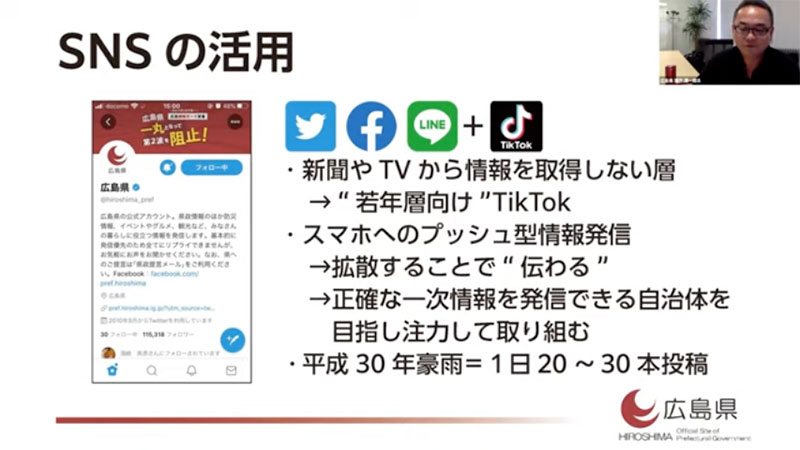
Paid media is also effective
Next, he spoke about paid media, which is a service that requires a fee to use. During the heavy rains of July 2018, it became clear that information was not reaching many foreign tourists and residents of Hiroshima Prefecture. It was while he was feeling this was an issue that he came across Morisawa's Catalog Pocket. He was attracted by the fact that it can translate into multiple languages, as well as the fact that information can be viewed without having to download a dedicated app, and began using it in November of last year. He posted a link to Catalog Pocket in "easy Japanese" on Twitter, along with a URL, which can be clicked to display multiple languages.
Sakuma nodded vigorously, agreeing that consideration for foreigners is extremely important, and then asked, "What is 'easy Japanese'?" To which Seto replied, "It means using the polite form of speech and keeping sentences as short as possible."
A participant asked via chat, "What difficulties did you face when introducing 'easy Japanese'?" to which he replied, "I struggled to define 'easy Japanese'. After studying online and in books, I arrived at the desumasu style."
Matsudo City apparently uses PR TIMES as paid media. During the COVID-19 pandemic, they issued an "Emergency Declaration of Human Rights Respect Due to the Spread of Infection," calling for an end to slander against people infected with COVID-19 and their families. "We announced this declaration at a regular press conference, but the response was lukewarm. So the next day, we ran a press release on PR TIMES, and the number of pageviews on our website roughly doubled, resulting in a huge response," says Saito.
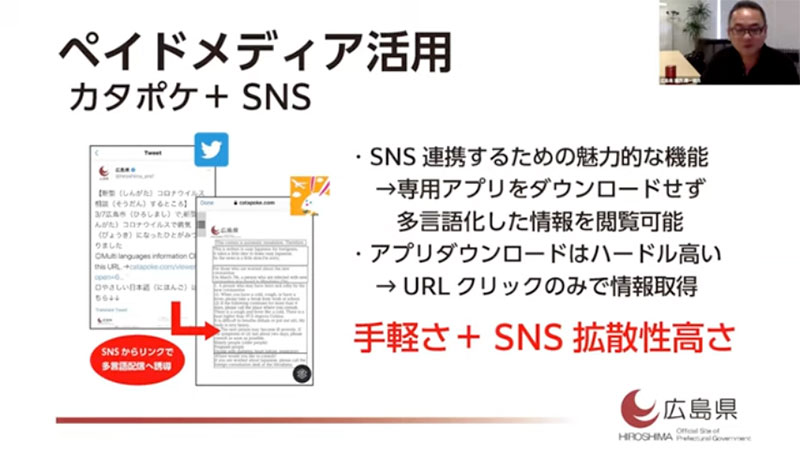
The approximately one-hour panel discussion was extremely productive and the time flew by. There were also many questions from the participants, indicating the high level of interest.
